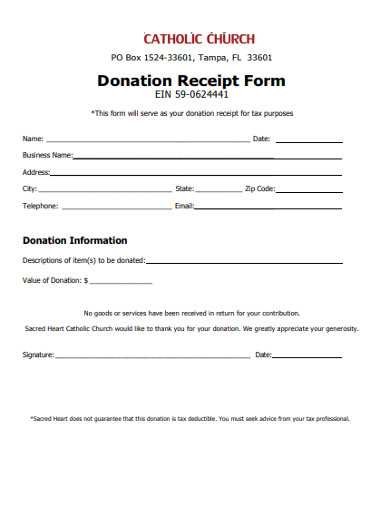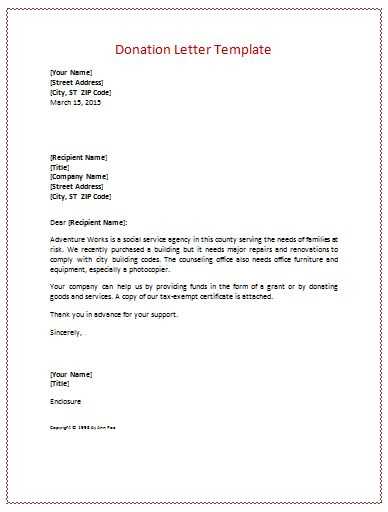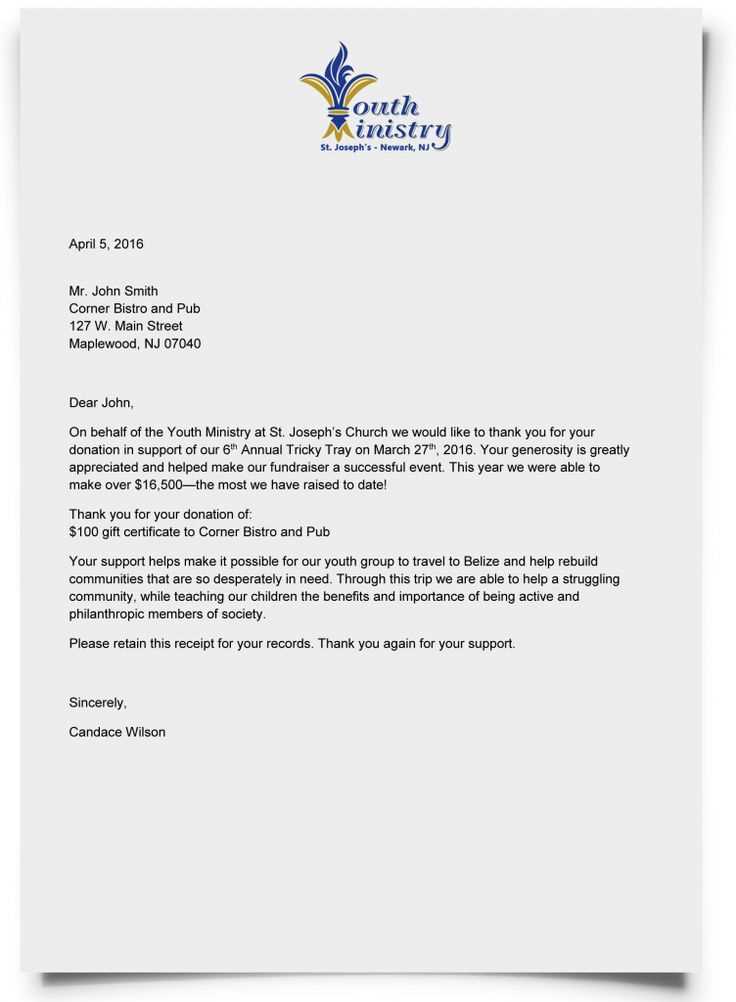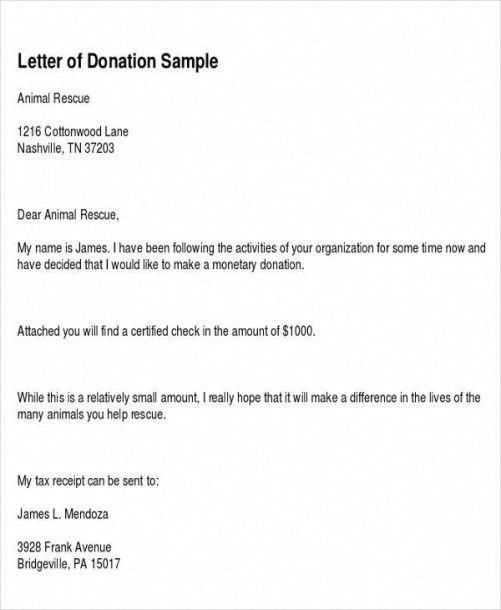Donation letter template for church

Start your donation request with a clear and direct appeal. Address the donor with a warm and welcoming tone, making it clear how their contributions will support the church’s mission. Use language that conveys gratitude and emphasizes the tangible impact their donation will make.
For example: “Dear [Donor’s Name], we are reaching out to invite you to partner with us in supporting the growth of our community. Your donation will directly fund our ongoing outreach programs, helping us to serve those in need.” This statement immediately connects the donor’s action to a meaningful cause, motivating them to give.
Keep the letter focused and concise. Mention the specific needs the church has, such as funding for building repairs, community events, or mission work. It’s helpful to offer donation options, whether through a one-time gift or a recurring contribution, and to make it easy for the donor to give through clear instructions.
For example: “We offer several ways to give, including online donations, checks, or in-person contributions at our Sunday services. No amount is too small, and every gift counts toward our shared goal.” Providing multiple options increases the likelihood of a response.
Finish the letter with a thank-you statement, reinforcing how much their support means to the church community. Acknowledge their generosity, and remind them that their gift is making a difference.
For example: “Thank you for your continued support. Together, we can make a lasting impact in our community and beyond.” This leaves the donor with a sense of pride in their involvement with the church’s work.
Here are the revised lines:
Use a direct and clear tone to express the purpose of the donation. For example:
- Before: “Your donations can help us reach our goals.”
- After: “Your donation directly supports our mission and helps us make a lasting impact in the community.”
Make the donor feel valued by expressing gratitude and the importance of their support:
- Before: “Thank you for your support.”
- After: “We are deeply grateful for your generosity and the difference you make.”
Offer clear instructions on how donations can be made:
- Before: “You can donate online through our website.”
- After: “To donate, visit our website and select the ‘Donate’ button. You can contribute using credit card, PayPal, or bank transfer.”
Include a call to action that motivates the reader:
- Before: “Consider making a donation today.”
- After: “Join us in making a difference–donate today and help us continue our work!”
- Donation Letter Template for Church
Writing a donation letter for a church should feel personal, yet professional. It’s about building connections with donors while expressing genuine gratitude for their support. Below is a simple and direct template that can be used for soliciting donations or thanking contributors.
Donation Request Template

Subject: Support Our Church’s Mission
Dear [Donor’s Name],
We are reaching out to ask for your help in supporting the important work we do at [Church Name]. With your generous contribution, we can continue to serve our community through [list church’s programs or outreach initiatives]. Your donation will directly impact [specific projects or needs].
We invite you to join us in making a difference by making a financial gift to [Church Name]. No contribution is too small. Together, we can reach new heights in serving others.
Thank you for considering a donation. We value your support and would love to talk more about how you can get involved. Feel free to contact us at [phone number] or [email address].
May God bless you for your generosity.
Sincerely,
[Your Name]
[Church Position]
[Church Name]
Donation Acknowledgment Template
Subject: Thank You for Your Generosity
Dear [Donor’s Name],
On behalf of [Church Name], I want to express our sincere gratitude for your generous donation of [donation amount]. Your gift is an incredible blessing to our church, and it helps us continue our mission of [describe church’s work].
We are truly thankful for your support. With your help, we can continue making an impact in the lives of many. As a token of appreciation, your donation will go toward [specific use of donation].
If you have any questions or wish to learn more about our ongoing projects, please don’t hesitate to contact us. We look forward to continuing our work with your support.
May you be blessed abundantly for your kindness and generosity.
Sincerely,
[Your Name]
[Church Position]
[Church Name]
| Donation Type | Suggested Amount | Purpose |
|---|---|---|
| One-time Donation | $[amount] | General Fund |
| Monthly Donation | $[amount] | Building Fund |
| Event Sponsorship | $[amount] | Outreach Programs |
Begin by using the donor’s full name in the salutation. Personalization establishes a connection and makes the donor feel valued. For instance, “Dear John and Mary Doe,” is more engaging than a generic greeting like “Dear Donor.”
Use Formal Titles

When addressing a donor in writing, always use formal titles such as “Mr.,” “Mrs.,” or “Dr.” unless you have a close personal relationship. This shows respect and acknowledges their position within the community. For example, “Dear Dr. Smith” or “Dear Mrs. Johnson” are appropriate choices.
Consider Their Preferences

If you know that a donor prefers a specific form of address, honor that preference. For example, some donors may prefer being addressed by their first name, while others prefer the more formal approach. Tailoring the greeting to their comfort shows attentiveness to their wishes.
In cases where a family is involved, it’s respectful to address all members. A greeting like “Dear the Thompson Family” shows inclusivity and acknowledges their collective support.
Being intentional and thoughtful in addressing donors will make your church donation letter more personal and meaningful.
Be clear and direct in your opening paragraph. State the purpose of the letter and the need for donations. Mention specific projects or ministries that will benefit from the funds. For example, you can highlight a community outreach program or a building project.
Provide a clear donation method. Outline the different ways people can contribute, such as online giving, checks, or cash. Make sure to include any necessary details, like a website URL or the church’s mailing address, so it’s easy for donors to respond.
Express gratitude. Let the reader know how much you appreciate their support. Acknowledge their past generosity if applicable, and express how important their contribution will be in furthering the mission of the church.
Offer a reminder of tax benefits. If donations are tax-deductible, include a reminder of this benefit. Specify if you will send a receipt or acknowledgment letter for their records.
Set a clear call to action. Encourage donors to act now by including a sense of urgency. For instance, mention any deadlines for fundraising or the positive impact of donating soon.
Personalize the message. Address the letter to the recipient by name whenever possible. Tailor your request to reflect their previous involvement or connection to the church. Personalized letters are more likely to engage and motivate the reader to give.
Be direct and specific about what you want from your audience. A clear call to action (CTA) removes any confusion and guides potential donors toward taking action. Avoid ambiguity–make it easy for them to understand how to contribute.
- Use simple, action-oriented verbs like “Give,” “Support,” or “Donate now.”
- State the exact purpose of the donation. For example, “Your $25 will provide meals for 10 families this month.”
- Make the process straightforward–provide clear instructions or a link where donors can quickly contribute online.
- Offer multiple ways to donate, such as online, by mail, or through direct bank transfers, to cater to different preferences.
- Include a sense of urgency when appropriate: “Donate today to make an immediate impact!”
A successful CTA is not just about asking for money–it’s about making it clear how donations will bring about meaningful change. Focus on the outcome your donors’ contributions will help achieve, and ensure they feel empowered to take action now.
Use the recipient’s name in the opening greeting. Addressing the person directly makes the letter feel more personal and relevant. For example, instead of a generic “Dear Friend,” use “Dear [First Name],” to establish a direct connection.
Incorporate specific details that demonstrate your knowledge of the individual’s involvement with the church. Mention a recent event they attended or a ministry they supported. This shows genuine recognition of their contributions and strengthens the personal touch.
Share meaningful stories or testimonials from church members that highlight the impact of the recipient’s past support. This approach connects their actions to real-world outcomes, emphasizing the value of their continued participation.
Ensure your tone remains warm and approachable throughout the letter. Avoid sounding overly formal or distant; instead, use a conversational style that aligns with the community atmosphere of your church.
Personalize the call to action. If asking for a donation, tie it to specific needs that align with the recipient’s known interests or previous support. For instance, “Your gift will directly support our youth ministry, which you’ve supported in the past.”
Finally, add a handwritten note or signature at the end of the letter. This small personal touch can significantly enhance the sense of connection and appreciation.
Send your donation letters shortly after the donor makes a contribution. Timing matters when showing appreciation. A prompt thank-you helps reinforce the donor’s sense of involvement and importance to the cause.
Consider aligning your letters with key holidays, such as Christmas or Easter. These times often carry increased charitable giving, and your letter can tap into the spirit of generosity.
Sending letters during annual campaigns also proves beneficial. Schedule your mailings to coincide with specific fundraising drives, so your letter feels part of a larger effort. This timing can increase the likelihood of future contributions.
Keep in mind the calendar. If there are specific church events or missions happening, follow up with a donation letter shortly after the event. This makes the letter feel more relevant and timely.
Lastly, sending letters around the end of the year allows donors to use their contributions for tax purposes. Many people are more inclined to donate during this time, knowing it benefits them financially.
Reach out within two weeks of sending your donation letter to ensure it was received and to show appreciation for any support. A phone call or personalized email can help strengthen your relationship with the donor. Let them know how their contribution will make a difference, providing specific examples when possible.
Personalize Your Follow-Up
Tailor your follow-up message to the donor’s history and preferences. If they have donated before, acknowledge their past support and express gratitude. Mentioning the specific programs or causes their donation will support can increase engagement and demonstrate the impact of their generosity.
Invite Further Engagement
Encourage further involvement beyond the donation. Invite the donor to upcoming church events, volunteer opportunities, or special services. Giving them multiple ways to stay involved builds a stronger, long-term relationship with the church community.
I removed duplicates while keeping the necessary meaning and style.
Ensure your donation letter clearly explains why the church needs the funds and how the donations will be used. Focus on building trust by being transparent about the church’s mission and goals. Provide a direct appeal to potential donors, highlighting the impact their contributions will have on the community and the church’s growth.
When crafting the letter, keep the tone warm and appreciative. Acknowledge the donors’ previous support, if applicable, and express gratitude for their continued involvement. It’s helpful to provide various donation methods to make it convenient for people to give. Whether it’s online, by check, or through a direct deposit, clarity in payment options encourages a higher response rate.
Make sure to include a clear call to action. Directly ask for support, and set a specific goal or deadline if possible. This gives a sense of urgency and purpose to the request. Be concise but personal; a letter that feels genuine and tailored to the reader’s connection with the church will be more successful in eliciting donations.
End the letter with a warm closing, reminding donors that their contributions are making a real difference. A personalized touch, like signing the letter from a specific church leader or including a handwritten note, can make a big impact and encourage a positive response.